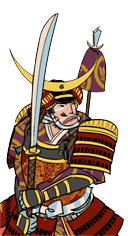
Basic Unit Statistics (can be modified by difficulty level, arts, skills, traits and retainers)
| Recruitment Cost | 1250 | |
| Upkeep Cost | 200 | |
| Melee Attack | 18 | 51% |
| Charge Bonus | 25 | 50% |
| Bonus vs Cavalry | 15 | 50% |
| Melee Defence | 12 | 34% |
| Armour | 9 | 60% |
| Morale | 40 | 80% |
Strengths & Weaknesses
- Versatile infantry, very good against cavalry and other infantry.
- Excellent armour makes them highly resistant to arrows.
- Excellent morale.
- Weak against matchlocks.
Abilities
- Hold Firm - This temporarily increases defence ability and stops morale from dropping, making the unit, and up to three nearby units, unbreakable for a short time.
Requires
Description
The deadly naginata is effective against all comers, especially in the hands of an expert.
The naginata is a weapon that favours the attack, like much samurai armament. Unlike a sword, however, it is equally useful against foot and horse. It can even be used as a rudimentary spear to ward off cavalry attacks. Despite his usefulness and aggressive qualities, a naginata hero and his followers should be handled carefully. They will die as readily as lesser men beneath a hail of arrows or bullets. Like all heroic forces, they can be swamped by sheer numbers of enemies, even lowly ashigaru, if they are unsupported. There are arguments as to the exact origin of the naginata. The Japanese had a genius for adopting and improving Chinese ideas, so an early form of the "guan dao" glaive may well be the parent of the naginata. The guan dao is certainly several centuries older than the Japanese weapon, and the "hoko yari", a spear issued to guards, was also often cited as a precursor to the true naginata. Regardless of the actual lineage, the curved, slicing blade on the end of a pole was independently developed around the world, and often adapted from a variety of agricultural implements. The billhook, glaive and many others are all blades on poles, and clearly weapons that owe much to basic farming tools. In the hands of an expert, all are deadly to footsoldiers and cavalry alike.